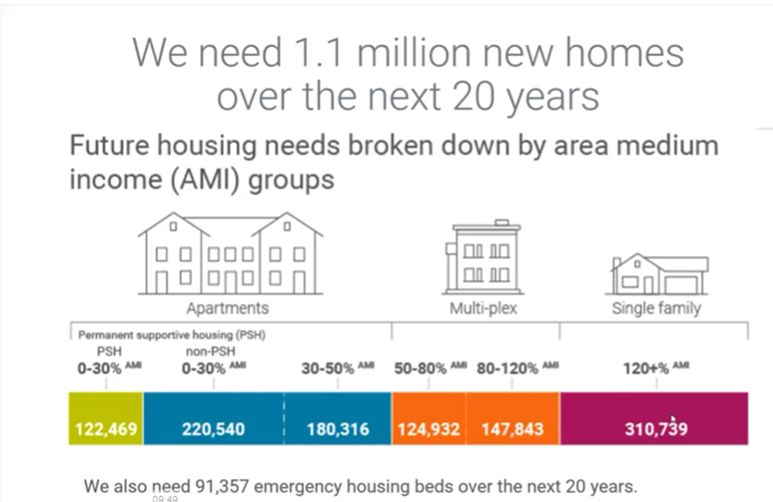Published on:

More than 100 people from various housing interests took part in an online workshop last month on the Middle Housing Model Ordinance. That bill was developed in response to an identified need for 1.1 million new homes over the next 20 years across the income spectrum, along with 91,357 emergency housing beds:

The 90-minute webinar, presented by the Washington State Department of Commerce (DOC), was part of the requirements of HB 1110, enacted earlier this year. Described by some as a landmark bill, it culminated years of advocacy by groups concerned about the state’s housing affordability.
HB 1110 mandates a deadline of six months from the July 23, 2023 effective date of the bill for publishing a model ordinance. (DOC provides technical assistance related to growth management.)
David Osaki with Commerce’s Growth Management Services led the discussion, with presentations by DOC’s consultant team. Their purpose was to gather critical feedback and uncover gaps or needs for additional materials and resources as they finalize the Model Ordinance.
The workshop was part of the public engagement process, which allowed for submission of public comments on the model ordinance and user guide until December 6. After that date, the Technical Committee will meet to review comments. The final model ordinance and user guide is scheduled for publication on January 23, 2024.
In opening the workshop, Osaki noted 77 cities statewide are subject to HB 1110. Of these, 55 cites plus Beaux Arts Village are in the four-county Puget Sound region (King, Kitsap, Pierce and Snohomish). Commerce categorized these cities into three tiers based on population. Cities in this region are subject to a June 30, 2025 deadline to implement the ordinance.
HB 1110 states: “Model ordinances preempt and supersede local development regulations if a city has not passed development regulations by the statutory deadline and remains in effect until the city takes all actions necessary to implement RCW 36.70A.365.”
Osaki also highlighted some of the legislative findings that informed various elements of the bill:
- Unprecedented housing crisis and a lack of housing choices;
- Innovative housing policies need to be adopted to meet the goal of one million homes by 2024;
- Homes at higher densities are more affordable by design;
- A wider variety of housing options would allow Washingtonians to live near where they work;
- More housing options would support key strategies for climate change.
The speakers said the draft model ordinance was developed using codes and examples from other jurisdictions, including Oregon, which passed a measure in 2019. They also reviewed definitions and nine types of middle housing, noting cities will have some latitude and flexibility regarding these types before the statutory deadline.
Also covered was the approach to design standards for the model ordinance, being mindful of requests to “keep it simple.” Eight design topics were addressed, ranging from entries to pedestrian and vehicle access, infrastructure and trees. Noting parking can add $5,000 to $25,000 per space, one speaker remarked, “Provisions for driveways and garages will be one of the most important design issues and challenges.”
An overview of the user guide, which contains six elements, was also part of the workshop. Both the recording of the workshop and draft user guide are available online.
In addition to HB 1110, the 2023 Legislature passed several other housing-related measures, including HB 1337 (covering ADUs), HB 1293 (Design Review), SB 5290 (Unit lot subdivisions, Impact Fees).
Commerce has created content on its website devoted to “middle housing in Washington.” It includes definitions, guidelines, grant information, and technical support materials for local governments, plus an online form to sign up for a mailing list.